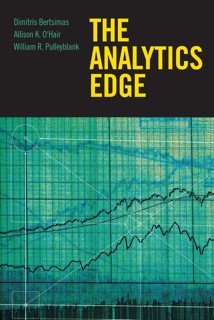Analytics
The Analytics Edge
Dimitris Bertsimas
The Analytics Edge provides a unified, insightful, modern and entertaining treatment of analytics. The book covers the science of using data to build models, improve decisions, and ultimately add value to institutions and individuals. The philosophical underpinnings of the book are that real world problems are usually complex and often will defined; they do not come with labels, meaning that they are not necessarily regression problems or optimization problems. The only objective reality is data, which itself may be incomplete and of questionable quality, and the role of models is to facilitate the solution of real world problems. Problems and data play a leading role in this book, while models play an essential but supporting role.
Finance
A Non-Random Walk Down Wall Street
Andrew Lo
For over half a century, financial experts have regarded the movements of markets as a random walk — unpredictable meanderings akin to a drunkard's unsteady gait — and this hypothesis has become a cornerstone of modern financial economics and many investment strategies. Here Andrew W. Lo and A. Craig MacKinlay put the Random Walk Hypothesis to the test In this volume, which elegantly integrates their most important articles, Lo and MacKinlay find that markets are not completely random after all, and that predictable components do exist in recent stock and bond returns. Their book provides a state-of-the-art account of the techniques for detecting predictabilities and evaluating their statistical and economic significance, and offers a tantalizing glimpse into the financial technologies of the future.
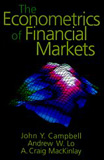 The Econometrics of Financial Markets
The Econometrics of Financial Markets
Andrew Lo
The past twenty years have seen an extraordinary growth in the use of quantitative methods in financial markets. Finance professionals now routinely use sophisticated statistical techniques in portfolio management, proprietary trading, risk management, financial consulting, and securities regulation. This graduate-level textbook is intended for PhD students, advanced MBA students, and industry professionals interested in the econometrics of financial modeling. The book covers the entire spectrum of empirical finance, including: the predictability of asset returns, tests of the Random Walk Hypothesis, the microstructure of securities markets, event analysis, the Capital Asset Pricing Model and the Arbitrage Pricing Theory, the term structure of interest rates, dynamic models of economic equilibrium, and nonlinear financial models such as ARCH, neural networks, statistical fractals, and chaos theory.
 The Industrial Organization and Regulation of the Securities Industry (National Bureau of Economic Research Conference Report)
The Industrial Organization and Regulation of the Securities Industry (National Bureau of Economic Research Conference Report)
Andrew Lo
The regulation of financial markets has for years been the domain of lawyers, legislators, and lobbyists. In this unique volume, experts in industrial organization, finance, and law, as well as members of regulatory agencies and the securities industry, examine the securities industry from an economic viewpoint.
Ten original essays address topics including electronic trading and the "virtual"stock exchange; trading costs and liquidity on the London and Tokyo Stock Exchanges and in the German and Japanese government bond markets; international coordination among regulatory agencies; and the impact of changing margin requirements on stock prices, volatility, and liquidity.
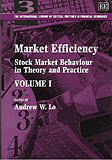 Market Efficiency: Stock Market Behaviour in Theory and Practice (International Library of Critical Writings in Economics)
Market Efficiency: Stock Market Behaviour in Theory and Practice (International Library of Critical Writings in Economics)
Andrew Lo
The efficient markets hypothesis is one of the most controversial and hotly contested ideas in all the social sciences. It is disarmingly simply to state, has far-reaching consequences for academic pursuits and business practice, and yet is surprisingly resilient to empirical proof or refutation. Even after three decades of research and literally thousands of journal articles, economists have not yet reached a consensus about whether markets - particularly financial markets - are efficient or not. These two volumes bring together the most influential articles surrounding the efficient markets hypothesis debate, from Paul Samuelson's pathbreaking proof that properly anticipated prices fluctuate randomly to Fischer Black's study of noise traders, from Eugene Fama's empirical implementation of the efficient markets hypothesis to Robert Merton's analysis of stock price volatility.
Logistics
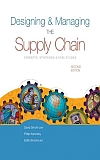 Designing & Managing the Supply Chain
Designing & Managing the Supply Chain
David Simchi-Levi, Philip Kaminsky, and Edith Simchi-Levi
Supply chain management, both in industry and in academia, has grown rapidly over the past several years mainly due to an increase in corporate goals of reducing manufacturing costs and the savings that come from planning and managing the supply chain effectively. Most textbooks do not include models and decision support systems robust enough for industry. Designing and Managing the Supply Chain: Concepts, Strategies, and Cases, 2/e by Simchi-Levi, Kaminsky and Simchi-Levi discusses the problems, models and concepts derived from issues related to effective supply chain management. This text is suitable for both academic study and practicing professionals. While many core supply chain management issues are interrelated, the authors have tried to make each chapter as self-contained as possible so that the reader can refer directly to chapters covering topics of interest. Each chapter utilizes case studies and numerous examples. Mathematical and technical sections can be skipped without loss of continuity. The accompanying CD-ROM also provides two simulations, the Computerized Beer Game and the Risk Pool Game and a computerized tool, new to this edition, for developing and executing supply chain contracts. These packages help illustrate many of the concepts discussed.
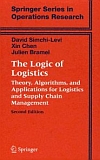 Logic Of Logistics: Theory, Algorithms, And Applications For Logistics Management
Logic Of Logistics: Theory, Algorithms, And Applications For Logistics Management
David Simchi-Levi, Xin Chen, and Julien Bramel
Fierce competition in today's global market provides a powerful motivation for developing ever more sophisticated logistics systems. This book, written for the logistics manager and researcher, presents a survey of the modern theory and application of logistics. The goal of the book is to present the state of the art in the science of logistics management. As a result, the authors have written a timely and authoritative survey of this field that many practitioners and researchers will find makes an invaluable companion to their work.
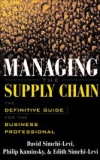 Managing the Supply Chain: The Definitive Guide for the Business Professional
Managing the Supply Chain: The Definitive Guide for the Business Professional
David Simchi-Levi, Philip Kaminsky, and Edith Simchi-Levi>
In today's environment of tight budgets and even tighter turnarounds, effective supply-chain management has become a core business requirement. Managing the Supply Chain adapts the number one supply-chain book on the college market to examine how professionals can consistently turn supply-chain strategy into a competitive advantage. This results-based book examines the experiences of today's most accomplished companies to demonstrate supply-chain innovation at work in the marketplace.
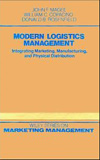 Modern Logistics Management, Linking Marketing, Manufacturing, and Physical Distribution
Modern Logistics Management, Linking Marketing, Manufacturing, and Physical Distribution
Donald B. Rosenfield, John Magee, and William Copacino
This comprehensive overview of logistics provides a conceptual framework for understanding the logistics system, the integration of its basic elements, and its relationship to the overall firm. Discusses both manufacturing and physical distribution, new technologies in each of these areas, and how they related to each other and to the company. New topics covered range from approaches to strategic logistics planning and multi-location inventory planning, to international logistics issues and future directions.
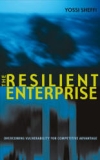 The Resilient Enterprise: Overcoming Vulnerability for Competitive Advantage
The Resilient Enterprise: Overcoming Vulnerability for Competitive Advantage
Yosef Sheffi
>Logistics, argues that a company's survival and prosperity depend more on what it does before such a disruption occurs than on the actions it takes as the event unfolds. In The Resilient Enterprise: Overcoming Vulnerability for Competitive Advantage, Sheffi explores high-impact/ low-probability disruptions, focusing not only on security but on corporate resilience the ability to bounce back from such disruptions and how resilience investments can be turned into competitive advantage.
Sheffi provides tools for companies to reduce the vulnerability of the supply chain they live in. And along the way he tells the stories of dozens of enterprises, large and small, including Toyota, General Motors, UPS, Intel, Amazon.com, the US Navy, and others from across the globe. Their successes, failures, preparations, and methods provide a rich set of lessons in preparing for and managing disruptions.
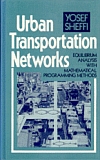 Urban Transportation Networks: Equilibrium Analysis with Mathematical Programming Methods
Urban Transportation Networks: Equilibrium Analysis with Mathematical Programming Methods
Yosef Sheffi
What happens to a company when the unimaginable occurs? When an earthquake hits its primary contract manufacturer? When labor strikes shut down an entire port? When terrorists cripple a transportation system?
Machine Learning
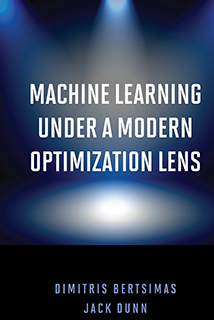 Machine Learning Under a Modern Optimization Lens
Machine Learning Under a Modern Optimization Lens
Dimitris Bertsimas and Jack Dunn
The book provides an original treatment of machine learning (ML) using convex, robust and mixed integer optimization that leads to solutions to central ML problems at large scale that can be found in seconds/minutes, can be certified to be optimal in minutes/hours, and outperform classical heuristic approaches in out-of-sample experiments.
Management Science
 Data, Models, and Decisions
Data, Models, and Decisions
Dimitris Bertsimas and Robert Freund
This book represents a departure from existing textbooks. Rather than covering methodology, the book introduces decision support systems through real world applications, and uses spreadsheets to model and solve problems. It uses management science techniques (statistics, simulation, probabilistic modeling and optimization), but only as tools to facilitate problem solving.
Manufacturing
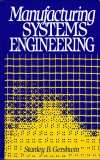 Manufacturing Systems Engineering
Manufacturing Systems Engineering
Stanley B. Gershwin
This book provides quantitative methods for the capacity analysis and real-time scheduling of manufacturing systems. It treats these issues as engineering problems, without slogans, and it faces technical details in an appropriate, useful way.
This book provides a fundamental description of some of the most important phenomena affecting material flow in manufacturing systems: machine failures, starvations, blockages, and set-ups. It has a point of view: that disruptions, while undesirable, are a fact of life in a factory. While effort should be expended to reduce them, or even to eliminate them, some amount of disruption is inevitable, and we should develop ways of predicting and limiting their negative effects. The book describes some potentially disruptive events that affect production, the control actions that managers can take in anticipation of or in response to the disruptions, and the consequences of the control actions. The goal is to contribute to the development of a rigorous, and useful, manufacturing systems science.
The emphasis in the early chapters is a capacity analysis of flow systems. The later chapters deal with the real-time control of manufacturing systems. Mathematical background in Markov processes, linear programming, and dynamic programming is provided.
Optimization
 Introduction to Linear Optimization
Introduction to Linear Optimization
Dimitris Bertsimas and John N. Tsitsiklis
The book is a modern and unified introduction to linear optimization (linear programming, network flows and integer programming) at the PhD level. It covers, in addition to the classical material, all the recent developments in the field in the last ten years including the development of interior points, large scale optimization models and algorithms and complexity of linear optimization. It emphasizes the underlying geometry, intuition and applications of large scale systems.
 Network Flows: Theory, Algorithms, and Applications
Network Flows: Theory, Algorithms, and Applications
Ravindra K. Ahuja, Thomas L. Magnanti, James B. Orlin
Bringing together the classic and the contemporary aspects of the field, this comprehensive introduction to network flows provides an integrative view of theory, algorithms, and applications. It offers in-depth and self-contained treatments of shortest path, maximum flow, and minimum cost flow problems, including a description of new and novel polynomial-time algorithms for these core models. For professionals working with network flows, optimization, and network programming.
 Optimization over Integers
Optimization over Integers
Dimitris Bertsimas and Robert Weismantel
The purpose of this book is to provide a unified, insightful, and modern treatment of the theory of integer optimization with an eye towards the future. We have selected those topics that we feel have influenced the current state of the art and most importantly we feel will affect the future of the field. We depart from earlier treatments of integer optimization by placing significant emphasis on strong formulations, duality, algebra and most importantly geometry.
OR in the Public Sector
Urban Operations Research
Richard C. Larson and Amedeo R. Odoni
Richard C. Larson and Amadeo R. Odoni Urban Operations Research Approximately 68 percent of the citizens of the world's developed countries live today in cities or in city-centered metropolitan areas. ¹ The economic and social fabric of these high-density clusters is elaborately interwoven, with the well-being of each citizen intricately enmeshed with the activities of others. Strong interdependencies arise in all areas of human need: food, shelter, safety, clothing, recreation, maintenance, energy provision, and so on. Servicing these needs requires highly structured transportation and communication networks throughout the city for effective provision of a variety of urban services: emergency medical, police, mail collection and delivery, fire protection, street and highway maintenance, utility repair, snowplowing, street cleaning, refuse collection, bus and subway transportation, taxi transportation, and so on. Increasingly, citizens are demanding more urban services, by type, quantity, and quality. Yet the ability of most cities in the United States and elsewhere to pay for additional services has been severely strained during the 1970s. The resulting pressure, between the demands for more and better services, on the one hand, and decreased costs, on the other, has created a strong need for improved management decision making in urban services. It is a primary purpose of this book to provide methods for assisting these decisions.
Probability
Applied Probability: Models and Intuition
Arnold I. Barnett
Applied Probability: Models and Intuition is an introductory textbook in Probability, written from the viewpoint of Applied Mathematics. Under that perspective, theoretical rigor is not denigrated, but the book puts a high premium on offering an intuitive overview of key theorems as well as clear evidence of their usefulness. Beyond teaching specific methods, the book strives to create real comfort with the underlying notions of probabilistic thinking. Grasping such ideas is essential if they are to be used with competence and confidence.
A primary objective of the book is to demonstrate that Probability and Statistics are, more than anything, just crystallizations of common sense. The reader should come away from each lesson understanding not only how a result was obtained but also why the outcome is plausible
Statistics
Applied Statistics: Models and Intuition
Arnold I. Barnett
This introductory textbook on applied statistics supports a one-semester course for graduate and undergraduate students in management, engineering, the natural sciences, and the social sciences.
What distinguishes the book is:
• An exceptionally large inventory of real-life examples drawn from many fields, with hundreds of solved examples and practice exercises, many based on the author’s experiences in industry, law, and government;
• An unusually strong emphasis on an intuitive understanding of the material, based on recognition that it isn’t enough for an answer to be correct: it should also make sense; and
• A conversational style of presentation, to make the book’s treatment of applied statistics more inviting and easier to grasp.

